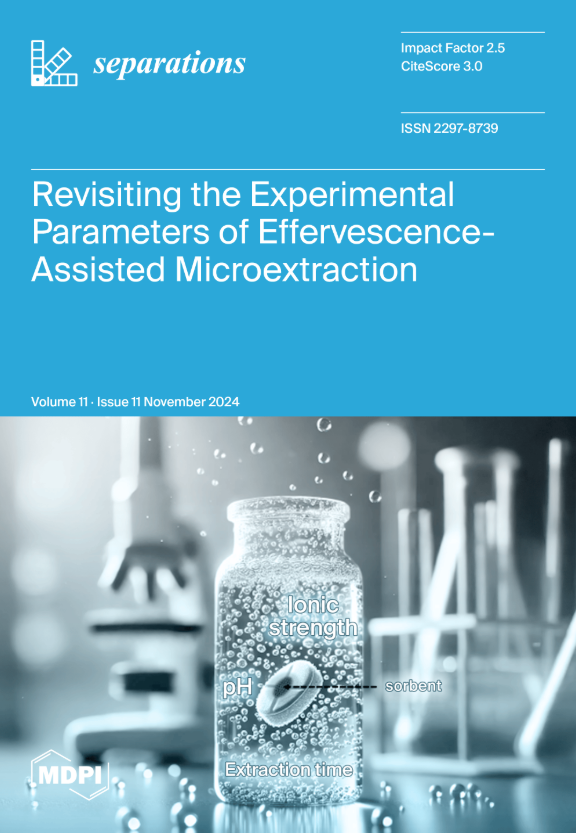Peucedanum longifolium 和 Rhizomatophora aegopodioides(Apiaceae)果实中的精油成分与其他相关类群的比较--化学计量学方法
IF 2.7
4区 工程技术
Q3 CHEMISTRY, ANALYTICAL
引用次数: 0
摘要
这项工作的目的是研究从 Peucedanum longifolium 和 Rhizomatophora aegopodioides(以前被归入 Peucedanum 属的一个物种)的果实中分离出来的精油成分,并将所得结果与以前研究过的其他相关物种(包括一些作者认为也被排除在 Peucedanum 属之外的类群)的结果进行比较。精油是在克莱文格尔型仪器中通过水蒸馏获得的,并使用 GC-FID 和 GC-MS 对其成分进行了分析。为了将这些数据与之前研究过的分类群的数据进行比较,采用了化学计量学方法;数据分析采用了多元统计方法:非计量多维标度(nMDS)和分层聚类分析。长叶松精油中含量最高的是单萜(79.7%),主要是α-黄柏烯(26.2%)、β-黄柏烯+柠檬烯(21.0%)和月桂烯(9.5%),其次是倍半萜(18.3%),主要是革兰氏烯 B(9.5%)。另一方面,在 R. aegopodioides 精油中占主导地位的是非萜类脂肪烃(46.1%),主要是正十一烷(16.5%)和正壬烷(11.3%)。此外,这种精油还含有大量倍半萜(25.1%),其中以 (E)-sesquilavandulol 含量最高(10.0%)。多元统计结果显示,R. aegopodioides 和 P. longifolium,以及 P. longifolium 和 P. officinale 的精油成分有明显的分离。此外,还观察到大多数不属于狭义 Peucedanum(严格意义上的 Peucedanum)的分类群样本聚集在一起,这与它们最近被列入单独的属是一致的。本文章由计算机程序翻译,如有差异,请以英文原文为准。
Composition of Essential Oils from Fruits of Peucedanum longifolium and Rhizomatophora aegopodioides (Apiaceae) with Regard to Other Related Taxa—A Chemometric Approach
The aim of this work was to investigate the composition of essential oils isolated from fruits of Peucedanum longifolium, and Rhizomatophora aegopodioides (a species which was previously placed in the genus Peucedanum), as well as to compare the obtained results to those available for other previously investigated related species (including taxa which are also, according to some authors, excluded from the genus Peucedanum). Essential oils were obtained via hydrodistillation in a Clevenger-type apparatus and their composition was analyzed using GC-FID and GC-MS. To compare these data to those of previously investigated taxa, a chemometric approach was applied; the data were analyzed using multivariate statistical methods: non-metric multidimensional scaling (nMDS) and hierarchical cluster analysis. The most abundant in P. longifolium essential oil were monoterpenes (79.7%), mostly α-phellandrene (26.2%), β-phellandrene + limonene (21.0%) and myrcene (9.5%), followed by sesquiterpenes (18.3%), mostly germacrene B (9.5%). On the other hand, dominant in R. aegopodioides essential oil were non-terpenic aliphatic hydrocarbons (46.1%), mainly n-undecane (16.5%) and n-nonane (11.3%). In addition, this essential oil also contained a notable quantity of sesquiterpenes (25.1%), with (E)-sesquilavandulol being the most abundant (10.0%). The results of multivariate statistics revealed a clear separation of the essential oil composition of R. aegopodioides and P. longifolium, as well as of P. longifolium and P. officinale. The clustering of the samples of most of the taxa that do not belong to the Peucedanum in the narrow sense (sensu stricto) was also observed, which is in accordance with their recent inclusion in separate genera.
求助全文
通过发布文献求助,成功后即可免费获取论文全文。
去求助
来源期刊

Separations
Chemistry-Analytical Chemistry
CiteScore
3.00
自引率
15.40%
发文量
342
审稿时长
12 weeks
期刊介绍:
Separations (formerly Chromatography, ISSN 2227-9075, CODEN: CHROBV) provides an advanced forum for separation and purification science and technology in all areas of chemical, biological and physical science. It publishes reviews, regular research papers and communications. Our aim is to encourage scientists to publish their experimental and theoretical results in as much detail as possible. There is no restriction on the length of the papers. The full experimental details must be provided so that the results can be reproduced. There are, in addition, unique features of this journal:
Manuscripts regarding research proposals and research ideas will be particularly welcomed.
Electronic files and software regarding the full details of the calculation and experimental procedure, if unable to be published in a normal way, can be deposited as supplementary material.
Manuscripts concerning summaries and surveys on research cooperation and projects (that are funded by national governments) to give information for a broad field of users.
The scope of the journal includes but is not limited to:
Theory and methodology (theory of separation methods, sample preparation, instrumental and column developments, new separation methodologies, etc.)
Equipment and techniques, novel hyphenated analytical solutions (significantly extended by their combination with spectroscopic methods and in particular, mass spectrometry)
Novel analysis approaches and applications to solve analytical challenges which utilize chromatographic separations as a key step in the overall solution
Computational modelling of separations for the purpose of fundamental understanding and/or chromatographic optimization
 求助内容:
求助内容: 应助结果提醒方式:
应助结果提醒方式:


